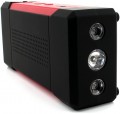Starting current
Rated starting current of the starter or booster (see "Type").
In this case, we mean the current that the device in the engine start mode can produce for a relatively long time (at least 30 s, or even more). This indicator must not be lower than the rated starting current consumed by the starter of the car — otherwise the device simply does not have enough power to effectively scroll the starter and start the engine. Information about the required starting current can be clarified by the documentation for the machine, or by the characteristics of the battery that is used in it as standard. For most passenger cars, this figure lies in the range from
200 to 400 A ;
less powerful starting devices are intended mainly for motorcycles and other similar vehicles, and more powerful ones for buses, trucks and other heavy equipment, among such “starters” there are models for
400 – 600 A and even
more.
Peak output current
Peak inrush current of the starter or booster (see "Type").
Peak current is the highest current that the device can deliver without problems for a short time (1 – 2 s). This current is noticeably higher than the nominal starting current (see above), which corresponds to the operation of a car starter: starting to spin up, the starter consumes a very high current, which, however, decreases almost immediately.
The peak inrush current of the ROM or booster must not be less than the peak inrush current of the starter. You can specify the latter according to the documentation for the car, or according to the characteristics of a regularly used car battery.
Built-in battery capacity
Capacity of the own battery provided in the design of the starter-charger.
As a rule, boosters and launchers with a power bank function are equipped with their own batteries (see “Type”). The main purpose of such a battery from the point of view of helping to “light up” is to provide the power necessary to start the engine. However, in some models the battery is responsible for other functions, such as the built-in compressor or flashlight. The larger the battery capacity, the longer the device can operate, and the more tasks it can perform on a single charge.
In starting devices with the powerbank function, this parameter is also given to estimate how much energy the battery can accumulate and then transfer to connected gadgets. It is important to consider that there is a nominal (declared) and real capacity - the latter is always less, because it takes into account the inevitable losses during energy conversion. Typically the difference is from 30 to 40%, i.e. a model with a conventional battery capacity of 10,000 mAh will not fully charge a smartphone with a 3,000 mAh battery three times, but at best will provide two power cycles, because in practice its working capacity is about 6,000 mAh. Therefore, it is not entirely correct to compare the mAh values of your gadget’s battery with the nominal capacity of the built-in battery - you should definitely take into account that the real capacity is always less than the “rated” one.

